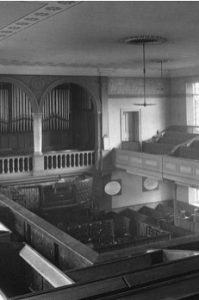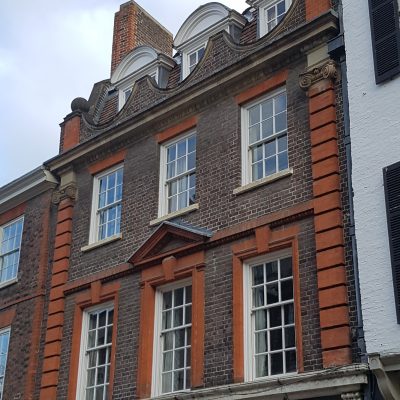Search by topic
- archaeology
- Building of Local Interest
- chapel
- charity
- church
- crime
- dressmaker
- fire
- Great Eastern Railway
- Listed building
- Mapping Relief
- medieval
- oral history
- poverty
- Public House
- Religious House
- Roman
- scholar
- school
- Then and Now
- tudor
- women
- work
- world war one
- world war two
Search by text
 St Andrew's Street Baptist Church
St Andrew's Street Baptist ChurchSt Andrew’s Street Baptist Church, St Andrew’s Hill (Hog Hill)
History of St Andrew's Baptist Church Cambridge
According to Pevsner this is ‘1903-4. A good specimen of G Baines and Son’s Neo-Perp with Art Nouveau touches.‘
Further information is on the church web site:
https://www.stasbaptist.org/Groups/239182/Our_History.aspx
The chapel in St Andrew’s Street and the one behind in Downing Place played an important part in the early history of Nonconformity in Cambridge.
The map above shows the ‘Anabaptist’ chapel at ‘w’ and the Independent (Congregationalist) chapel at ‘z’.
Behind the site of the Baptist church had been founded in the reign of Charles II, 1689, in Downing Place, an assembly for the Presbyterians. In 1691 came a minister, Joseph Hussey who persuaded his following, the Great Meeting as they were called, , to adopt Congregationalism.
Members who objected broke away and joined the congregation of a chapel in Green Street which was still Congregational. The new arrivals persuaded this chapel to turn to the Presbyterian style of worship.
After Joseph Hussey left Cambridge there was a split between the wealthier members of the congregation who wanted as pastor, a Mr Throgmorton, while the poorer preferred a Mr Davis. The two men shared the pulpit initially, one in the morning the other in the evening, until 1720 when access to the pulpit was denied to Mr davis.
As a result In 1721 the portion of the congregation supporting Mr Davis broke away and started a Baptist congregation, using as a meeting house a stable and granary in a place called the Stoneyard, the current site of St Andrew’s, next to the Spinning House.
Robert Robinson and Robert Hall, two great preachers, thereafter contributed to the expansion of the community and the church was enlarged to welcome a congregation of more 800. Members included many wealthy businessmen as well as intellectuals from the Cambridge Colleges who were attracted by the rhetorical skills of Robinson and Hall.
The story of Robert Hall and his friendship with James Nutter, the miller of Cambridge, can be found told here:
6 months in the life of James Nutter Miller of Cambridge
Josiah Chater records in his diary that he used to attend at least once on Sundays where in September 1845 he became a Sunday School teacher and was in charge of the library. His uncle William Adams became a full member of the Baptist Church in 1806 and was a deacon at St Andrew’s from 1823 until his death in 1849. Doubtless it was he who introduced Josiah.
1846 Josiah Chater recorded that during the Irish famine a collection was made 17th January of £236, ‘an enormous sum for a small place like this‘. A second collection on the following Sunday resulted in a further £264.
1849 Death of William Adams, a prominent Baptist philanthropist. Buried at Histon Road
1855 Josiah Chater records that Charles Spurgeon came twice to preach at St Andrew’s Baptist church, 6th April and 8th August. “Agnes and I heard him and liked him very much indeed: he gave an excellent sermon.”
Charles Spurgeon became the paster of Waterbeach aged 18 in 1852. He had preached his first sermon shortly before in the village of Teversham, almost by accident. His fame as a preacher soon spread and he went to New Park Street Chapel in Southwark in 1853. by the age of 22 he was the most popular preacher of his day.
1861 18th May, Josiah Chater recorded in his diary that,
a University man, drunk, came into our chapel in the gallery opposite me and, taking off his cap, said in a loud voice to our minister, Mr Robinson, Oh, you venerable old heretic, for which offence he was duly incarcerated in the lock-up and hauled before the magistrate on the Monday following. He was liberated on the understanding he should see Mr Robinson alone, and apologise.
In 1874 the congregation moved to Trumpington Street where at the northern corner of Little St Mary’s Lane a new Chapel was erected.

The car belonging to John Chivers with chauffeur outside St Andrew’s Baptist Chapel c.1910. Frank Chivers is not in the car.
1953
Ann Newman’s parents were married here and the marriage was photographed by Stearn and Sons. She has written about the loss of her parents here:
https://www.annstracts.com/2022/06/touching-memories-found-through-the-grief-of-losing-a-parent/


Contribute
Do you have any information about the people or places in this article? If so, then please let us know using the Contact page or by emailing capturingcambridge@
License
This work is licensed under CC BY-NC-SA 4.0





















